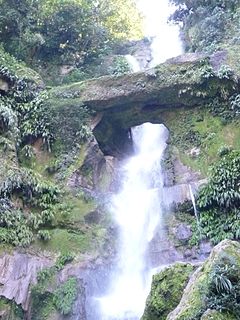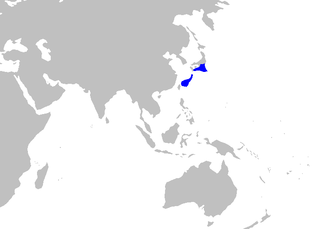The large Palau flying fox is an extinct species of medium-sized megabats from the Palau Islands in Micronesia. It had brownish fur with long, silvery hairs on its belly, and a wingspan of about 60 cm. It probably became extinct around 1874, possibly due to overhunting. It is known from two specimens, one of which is in the Natural History Museum in London.

The Rio Abiseo National Park is located in the San Martín department of Peru. UNESCO pronounced it as Natural and Cultural Heritage of Humanity in 1990. The park is home to many species of flora and fauna, as well as the location of over 30 pre-Columbian archaeological sites. Since 1986, the park has not been open to tourism due to the fragile nature of both the natural and archaeological environment.

The salamander shark or salamander catshark is a little known catshark that inhabits a range from Japan and the East China Sea, on the upper to middle continental slope at depths of 358–895 m. Specimens of this species can attain a total length of at least 64 cm. This catshark is a potential bycatch of trawl fisheries operating within its range, but no details are available. There are high levels of squalene in this catshark's liver. The reproduction of this catshark is oviparous.

A species that is extinct in the wild (EW) is one that has been categorized by the International Union for Conservation of Nature as known only by living members kept in captivity or as a naturalized population outside its historic range due to massive habitat loss.

Rickett's big-footed bat is a species of vesper bat. It can be found in southern and eastern China, Vietnam, and Laos. This species has often been called Myotis ricketti, but the older M. pilosus has priority. The erroneous reporting of the type locality as being in Uruguay by Wilhelm Peters led to the dual naming.

The hairy long-nosed armadillo or woolly armadillo is a species of armadillo in the family Dasypodidae. It is endemic to Peru. Its natural habitats are subtropical or tropical moist lowland forest and subtropical or tropical moist montane forest. The International Union for Conservation of Nature used to consider it a "vulnerable species" but has changed this assessment to "data deficient" because so little is known about the animal and the threats it faces.

The Somali hedgehog is a species of mammal in the family Erinaceidae. It is endemic to Somalia and Somaliland. The Somali hedgehog is nocturnal.
Speleoperipatus is a monospecific genus of velvet worm in the Peripatidae family, containing the single species Speleoperipatus spelaeus.

Hydrotarsus compunctus is a species of beetle in family Dytiscidae. It is endemic to Canary Islands.

Onychogomphus is a genus of dragonflies in the family Gomphidae. They are commonly known as Pincertails.
Onychogomphus pilosus is a species of dragonfly in the family Gomphidae. It is found in Ethiopia, Kenya, and Tanzania.
Potamonautes pilosus is a species of crustacean in the family Potamonautidae. It is found in Kenya and Tanzania. Its natural habitat is rivers.
Hicksbeachia pilosa is a small tree in the family Proteaceae. This rare species is endemic to the rainforests of the wet tropics region of northeastern Queensland, Australia. It was first described in 1988 by Australian botanist Peter H. Weston, after a collection by Garry Sankowsky and Peter Hind in 1986 at Bobbin Bobbin Falls in North Queensland. Its specific name is the Latin adjective pilosus "hairy".
Indiophonus pilosus is a species of beetle in the family Carabidae, the only species in the genus Indiophonus.

Lupinus pilosus, commonly known as blue lupine, is a species of flowering plant from the family Fabaceae which is endemic to Israel where it is found in Mediterranean scrubland. It has a 30–70 centimetres (12–28 in) long stem and 3–8 centimetres (1.2–3.1 in) long legume. The species blooms from February to May. The species have white coloured flowers which are 1–1.5 centimetres (0.39–0.59 in) long and pods the diameter of which is 3–8 centimetres (1.2–3.1 in). In Israel the Lupinus pilosus has blue flowers with white vertical spot at the middle.

Dicranocephalus is the sole genus of true bugs in the family Stenocephalidae. There are about 30 described species in Dicranocephalus.










